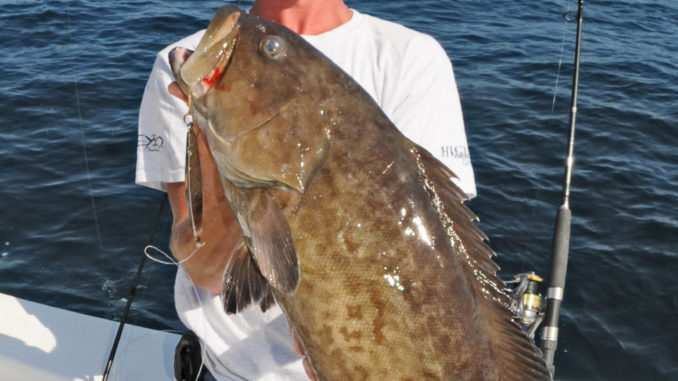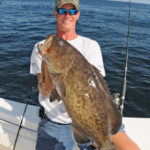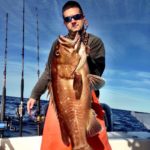
Jigging for offshore bottomfish is a great way to get spring cranked up along North Carolina’s Cape Fear coast.
On the Cape Fear coast, spring mornings can come very early. When the forecast is for light and slight wind, there is a rash of pre-dawn activity at the boat ramps and marinas as everyone makes last-minute preparations to head offshore.
In spring, many hardcore anglers head to the edge of the Gulf Stream, generally a run of 45 miles or more, from Masonboro Inlet out of Wrightsville Beach, N.C. Traditionally, bluewater anglers trolled all day after arriving on their spot. The advent of vertical jigging, however, has changed many spring days offshore.
Fishermen with jigging tackle in their arsenal are enjoying more productive trips, a more interactive experience, and a huge expansion of target species. On days where temperature breaks are way offshore or the water is cooler and “dirty,” jigging is often an angler’s best bet, by far. If you haven’t jigged before, what are you waiting for?
Steele Park captains the Catherine Anne, a 43-foot Rybovich with twin diesels. Mornings early in spring, he’s often found along the break at the 20-fathom line east of the Frying Pan tower. He carries two classes of jigging outfits in both conventional and spinning to target both bottomfish and suspended pelagics and said that alternating between conventional and spinning is a great way to relieve angler fatigue. As the different types exercise different muscle types — not to mention different arms for rod-holding — he or she simply swaps rods. All of his reels are spooled with either Diawa or JB metered braid, meaning that the color of the braid changes every 10 meters.
Before he even thinks about sending a jig down, Steele has to find productive water. He makes a series of low-speed runs over the ledges and livebottom he has marked, constantly checking his Furuno bottom machine, which is paired with a 1-kilowatt transducer and gains manually adjusted for better data. At 5 to 6 knots, the bottom will show up much better on the screen than when the boat is on plane. When he finds either an active bottom or suspended fish, he marks it with the cursor. He then stops the boat and watches the chartplotter for several minutes so he can tell exactly the direction his boat is drifting. Finally, he uses the angle created on the chartplotter to set the boat so he will drift right over the spot where he wants to drop, leaving enough distance to give him time to rig up before he hits his mark.
Most days, a simple dead drift will work, but on days with a lot of current or when the wind and current are coming from the same direction, it may be necessary to clutch the engines in reverse to slow it down. Steele said that he doesn’t want to be drifting faster than about 2.5 knots, or it makes his time over productive water too short.
If the action appears to be near the bottom, Steele and his crew go straight for the shorter, XXH Trevala rods. With the braided line finished in a 40-turn Bimini twist, they loop on 100-pound fluorocarbon leaders and crimp on 7-ounce Roscoe jigs from Blue Water Candy. Steele said they sink better than any other available, and their glow-in-the-dark paint makes them particularly attractive to bottom dwellers.
He instructs his anglers let the jigs fall all the way to the bottom, but immediately put the reel in gear and get tight. He then tells his anglers to “rip” the jig five times, aggressively jerking it up, but only reeling in a bit of line each time. Most of the time, bites from this style of fishing will come from the bottom 25 feet of the water column. After five good rips of the jig, he lets it fall back to the bottom again, then starts the process all over.
For bottom-jigging, his reels’ drags are virtually locked down. With the braid having no stretch, this ensures that a grouper or amberjack can’t take you into the rocks, as long as you immediately starts to wind when a rod doubles over and a hook is set. Jigging rods are engineered to pressure the fish with the bend of the blank, which will often curve almost down to the butt on a larger or stubborn fish. This is stressful fishing on an angler, to be certain, but constant pressure on the fish will get it moving in an upward fashion, and fairly quickly.
Quite a few different species can be caught this way. Aside from the collection of groupers, Steele has caught giant amberjack, red snapper, mutton snapper, vermillion snapper, black sea bass, African pompano, cobia, rosefish and cornetfish on bottom jigs, and more surprises are certainly in the future. Working out to deeper water, species like snowy grouper, gray tilefish, and golden tilefish will readily take a jig as well. Once you have cranked up a 30-pound tilefish from 50 or even 100 fathoms of water with braid and no assistance, you will certainly appreciate being able to switch arms to the other style of rod for the next fish.
Sharks are unwanted customers when it comes to bottom-jigging. While it’s possible to get one or two to the boat on occasion, more often than not they end up biting or chafing through expensive fluorocarbon leaders and keeping your expensive jigs, rings and hooks. When you end up in sharks, Steele said the only way to handle is to just move on. With plenty of ledges and stretches of livebottom to test out, there’s no sense wasting time and money around toothy friends. That being said, after any encounter with a bottomfish, shark or not, it’s a good practice to check your leader for nicks and abrasions. Fishing around rocks and reefs is a great way to weaken your leader and lose a trophy on the next bite. Cutting and re-crimping above the damage doesn’t take long, and it will save you fish and money in the long run.
Another great way to expand your offshore catch is to target suspended fish with jigs. Often, fish will suspend over ledges, livebottom or wrecks, and they will be seen on the bottom machine, but other times, you will simply encounter them while trolling. If you have run circles over a school of bait multiple times with no trolling bite, you can always drop a jig to change your fortune. Steele opts for somewhat lighter tackle here, using H or MH coded Trevala rods and 60-pound braid, with a 60- or 80-pound fluorocarbon leader looped on. He still crimps his jigs, but generally uses 5-ounce Shimano jigs in either the Butterfly or Flat-Fall series. He said the increased action of these jigs in conducive to getting bites from suspended fish, especially blackfin tuna, often the desired species.
When targeting suspended fish, the color change of the braid becomes extremely important. Steele said that to have the best success, you need to use the color changes to stop the jig just above where you mark the bait. He theorizes that tuna are more likely to chase a jig upwards rather than downwards, and that dropping the leader and braid past them in the water column may actually spook them.
When Steele has his anglers in the strike zone, he tells them to flutter the jig several times, then to simply bounce it up and down before retrieving. The idea is to keep the line as close to vertical as possible. When the jig gets further away from vertical, it is best to retrieve and then drop again. Often, the jig will get hammered on the retrieve.
It’s beneficial to fish a lighter drag here than you do when targeting bottomfish. Tuna will make several runs when hooked, so use the reel in addition to the rod to wear them out. In addition to blackfin, jiggers often encounter yellowfin, false albacore, king mackerel and even wahoo when jigging. When a yellowfin or wahoo takes your jig, it’s time to back off of that drag even more so that you have a chance of landing the fish.
When you go out jigging in the early season, you won’t be the only ones on the water using this technique. Officials at Tex’s Tackle in Wilmington said the store’s jigging business has grown to where it’s the dominant offshore technique for area fishermen in early spring and stays No. 1 until dolphin get thick enough to consistently target. Roscoe, Shimano and Blue Blue, a new, Japanese-stye jig with one flat side and one rounded side, are the top three products fishermen are buying.
One thing is for certain, the jigging craze is here, it’s spreading, and it’s not going away any time soon. If you’re not doing it already, it just might be time to learn.
DESTINATION INFORMATION
HOW TO GET THERE — Wrightsville Beach is known as the epicenter of North Carolina offshore jigging, but any angler headed to at least 20 fathoms in the spring would be well-served to bring some jigging tackle to increase their odds when bottomfishing. Wrightsville Beach is on US 74, east of Wilmington, best accessed by I-40 and US 421 from points inland, US 17 from north and south along the coast.
WHEN TO GO — Early spring is when jigging takes center stage in the waters around Cape Fear, but anglers will continue to jig as the water keeps warming up, especially when conditions aren’t ideal for trolling.
BEST TECHNIQUES — Light rod-and-reel outfits designed especially for jigging, paired with braided line, fluorocarbon wind-on leaders and jigs weighing from 4 to 7 ounces are the ticket. Conventional or spinning tackle can be used, provided reels have the line capacity to get a jig down and strong-enough drags to put pressure on extremely strong fish in an up-and-down fight.
FISHING INFO/GUIDES — Mike Jackson, LiveLine Charters, Wrightsville Beach, N.C., 910-686-7271, www.livelinecharters.com; Rick Croson, Living Waters Guide Service, Wrightsville Beach, N.C., 910-620-7709, www.livingwatersguide.com; Brant McMullan, Capt. Brant’s Fishing Adventures, Ocean Isle Beach, N.C., 910-575-3474, www.oifc.com; Tex’s Tackle, Wilmington, N.C., 910-791-1763, Wilmington, N.C., www.texstackle.com. See also Guides and Charters in Classifieds.
ACCOMMODATIONS — Sleep Inn/MainStay Suites, Wilmington, 910-392-1741 or 910-313-6665; Pleasure Island Chamber of Commerce, etc…..
MAPS — Profinder Charts, 910-512-6700 www.prochipusa.com; Maps Unique, 910-458-9923, www.mapsunique.com.





Be the first to comment